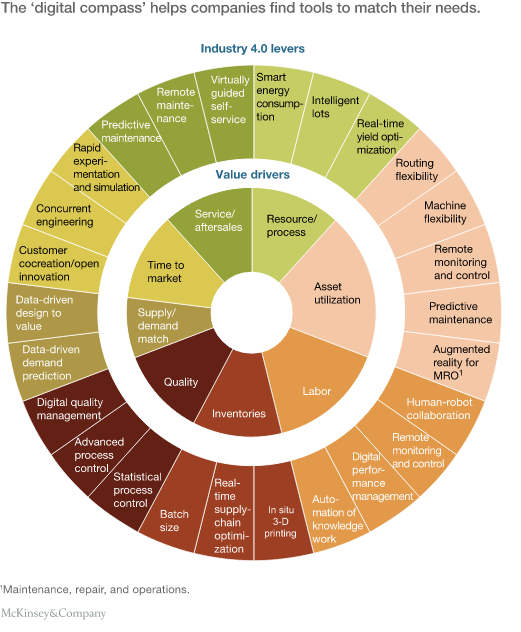Insight
Published and updated
Manufacturing Technology: 4 Top Trends for SMB and Enterprise
Four manufacturing technology trends consistently pop up in predictions for the next five years: the Internet of Things (IoT), robotics, 3D printing and predictive analytics.
What’s not always obvious is how different sized manufacturers implement and use these technologies. A small to medium-sized business (SMB) might take a much different path to the IoT than an enterprise-level company.
So what are the differences? And the similarities?
IoT: The New Manufacturing Technology Platform
I view the IoT as a technology platform that helps manufacturers of all sizes get more out of their software, hardware, machinery, processes and employees. The IoT is the network connectivity behind all the other technologies mentioned in this post.
For small manufacturers, the IoT often emerges as a byproduct of solving a business problem. For example, say you want to add a few small robot arms to increase efficiency and productivity. Those arms will come with sensors and software that let you track their performance.
Congratulations, you’ve begun connecting to the IoT.
Now you can expand with 3D printing, predictive analytics and other products that collect and exchange even more data.

For enterprise manufacturers, IoT will lead the way in many initiatives. Gartner points to manufacturing-as-a-service, automated background tasks and algorithm-based, smart-machine production strategies. An example of the latter is the GE Predix platform.
Robotics: Much More Efficient Than Their Human Overlords
According to Universal Robots, “cobots,” or collaborative robots, make sense for small and mid-sized manufacturers because they’re:
- Small enough to use with limited floor space;
- Safe enough to work with humans in close proximity;
- Able to be programmed and maintained without specialized expertise;
- Affordable enough to justify the investment; and
- Driving big productivity and quality payoffs.
Other SMB-friendly features include quick setup and multi-function usability.
For enterprise manufacturers, robots provide the efficiency needed to meet accelerated demand. According to the Robotics Industries Association, aerospace and automotive plants throughout North America need efficient, high-quality robot automation to help with such tasks as painting, drilling, fastening and assembly.
3D Printing: DIY Manufacturing Technology
Also known as additive manufacturing, 3D printers create physical objects layer by layer. The idea has been around for decades, but until recently only those with deeper pockets could afford it.
Today, 3D printing is affordable enough that even ambitious teens are making use of the technology. With many 3D printers under $1,000, these DIYers create 3D models and outsource the manufacturing. For SMBs, 3D printing is not only affordable, it’s becoming indispensable.
As 3D printing accuracy improves and the size of printable objects increases, so does enterprise manufacturers’ reliance on the technology.
Predictive Analytics: Do You Employ a Data Scientist?
With predictive analytics—collecting meaningful, actionable insights from data produced by your IoT-connected assets—the difference between SMB and enterprise comes down to people instead of technology.
Enterprise manufacturers often employ data scientists who can analyze and interpret this flood of ‘new’ data, but SMBs need the software to be much more intuitive.
Manufacturers of all sizes can use predictive analytics software to:
- Improve product quality by integrating metrics about performance and customer response;
- Forecast demand to increase supply chain visibility and allocate resources;
- Maximize machine utilization based on demand forecasts;
- Increase equipment uptime by identifying patterns that lead to machine failures.
Is “Industry 4.0” What’s Next for Manufacturing Technology?

It looks that way. Industry 4.0, or the fourth industrial revolution, forecasts the “smart factory,” which will be made up of cyber-physical systems, the IoT and the Internet of Services (or cloud computing).
According to McKinsey & Company, “Industry 4.0 is gathering force, and executives should carefully monitor the coming changes and develop strategies to take advantage of the new opportunities.”
How will Industry 4.0 impact small, mid-sized and enterprise manufacturers? We’re all going to find out very soon.